Themed collection Air quality in megacities

Poster list
Faraday Discuss., 2021,226, 629-631
https://doi.org/10.1039/D1FD90018H
List of participants
Faraday Discuss., 2021,226, 632-634
https://doi.org/10.1039/D1FD90019F
Concluding remarks: Faraday Discussion on air quality in megacities
This paper provides a brief summary of the virtual Faraday Discussion: Air Quality in Megacities.
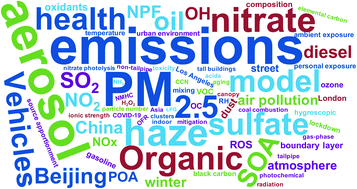
Faraday Discuss., 2021,226, 617-628
https://doi.org/10.1039/D0FD90037K
Using highly time-resolved online mass spectrometry to examine biogenic and anthropogenic contributions to organic aerosol in Beijing
We study the anthropogenic and biogenic contributions to organic aerosol.

Faraday Discuss., 2021,226, 382-408
https://doi.org/10.1039/D0FD00080A
Introductory lecture: air quality in megacities
This introduction provides an overview of air quality in megacities, sources and atmospheric processing of emissions, impacts on health and climate, mitigation strategies, and challenges of COVID-19.

Faraday Discuss., 2021,226, 9-52
https://doi.org/10.1039/D0FD00123F
Investigating the background and local contribution of the oxidants in London and Bangkok
Trends of oxidant levels in London and Bangkok roadside sites.
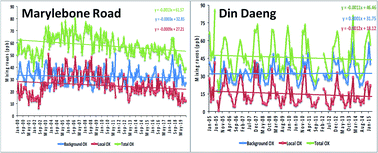
Faraday Discuss., 2021,226, 515-536
https://doi.org/10.1039/D0FD00086H
Vertical profile of particle hygroscopicity and CCN effectiveness during winter in Beijing: insight into the hygroscopicity transition threshold of black carbon
The critical coating thickness (MRc) defining the BC transition between being hydrophobic to hydrophilic was determined by combining HTDMA, CPMA and SP2 measurements.
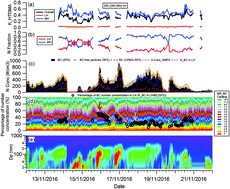
Faraday Discuss., 2021,226, 239-254
https://doi.org/10.1039/D0FD00077A
Difference in ambient-personal exposure to PM2.5 and its inflammatory effect in local residents in urban and peri-urban Beijing, China: results of the AIRLESS project
We quantified and compared the personal and ambient exposure to PM2.5 and the related health impact among residents in Beijing, China.
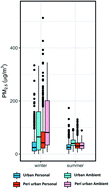
Faraday Discuss., 2021,226, 569-583
https://doi.org/10.1039/D0FD00097C
Multiphase chemistry experiment in Fogs and Aerosols in the North China Plain (McFAN): integrated analysis and intensive winter campaign 2018
High-RH-favored multiphase reactions can significantly change the chemical composition of fine particles and thereby modify their physicochemical properties.
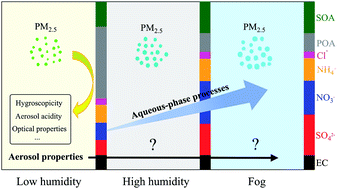
Faraday Discuss., 2021,226, 207-222
https://doi.org/10.1039/D0FD00099J
PM2.5 pollution in China’s Guanzhong Basin and the USA’s San Joaquin Valley mega-regions
We update a model of PM2.5 pollution in the San Joaquin Valley in California, USA, and identify parallels to the Guanzhong Basin, China. We suggest future experiments, data analyses, and modeling to better understand the regional situations to develop emission reduction strategies.
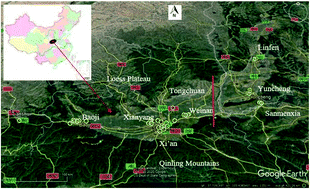
Faraday Discuss., 2021,226, 255-289
https://doi.org/10.1039/D0FD00094A
The role of a suburban forest in controlling vertical trace gas and OH reactivity distributions – a case study for the Seoul metropolitan area
This study presents vertical distributions of trace gases and OH reactivity in Seoul Metropolitan Area. The comparison between a suburban ground site and an airborne platform illustrates a rapid photo oxidation in the very bottom of the boundary layer.
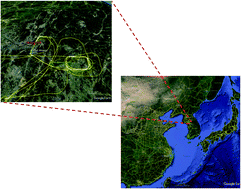
Faraday Discuss., 2021,226, 537-550
https://doi.org/10.1039/D0FD00081G
An evaluation of source apportionment of fine OC and PM2.5 by multiple methods: APHH-Beijing campaigns as a case study
This paper reports an evaluation of multiple source apportionment methods for OC and PM2.5.
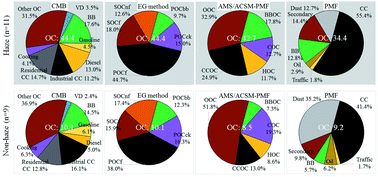
Faraday Discuss., 2021,226, 290-313
https://doi.org/10.1039/D0FD00095G
Insights into air pollution chemistry and sulphate formation from nitrous acid (HONO) measurements during haze events in Beijing
We integrate observations of gas phase species and time-resolved aerosol composition to explore observational constraints on the mechanisms responsible for sulphate growth during the onset of haze events in Beijing.

Faraday Discuss., 2021,226, 223-238
https://doi.org/10.1039/D0FD00100G
Asia Pacific road transportation emissions, 1900–2050
We present an assessment of the historical and future emissions of on-road transportation and strategies to tackle emission challenges in Asia Pacific.
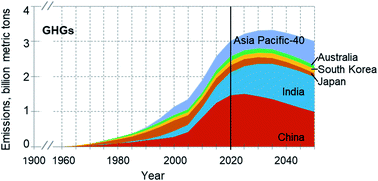
Faraday Discuss., 2021,226, 53-73
https://doi.org/10.1039/D0FD00096E
Diurnal and weekly patterns of primary pollutants in Beijing under COVID-19 restrictions
Restrictions on movement in Beijing to limit the COVID-19 epidemic tended to change the daily and weekly cycles of emissions of primary pollutants.
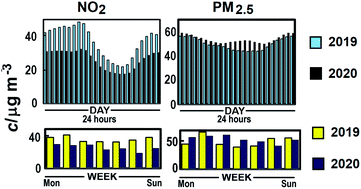
Faraday Discuss., 2021,226, 138-148
https://doi.org/10.1039/D0FD00082E
Simulation of primary and secondary particles in the streets of Paris using MUNICH
This study presents the new version of the local-scale model MUNICH, capable to represent the formation of secondary species in gas and particulate phases. A sensitivity test is performed to investigate the formation of secondary aerosols in streets.
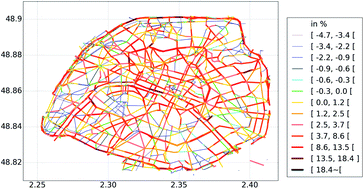
Faraday Discuss., 2021,226, 432-456
https://doi.org/10.1039/D0FD00092B
The persistence of a proxy for cooking emissions in megacities: a kinetic study of the ozonolysis of self-assembled films by simultaneous small and wide angle X-ray scattering (SAXS/WAXS) and Raman microscopy
We report an ozonolysis kinetics study on a semi-solid (self-assembled) proxy for cooking emissions, revealing film thickness- and phase-dependent reactivity.

Faraday Discuss., 2021,226, 364-381
https://doi.org/10.1039/D0FD00088D
Tracer-based characterization of source variations of PM2.5 and organic carbon in Shanghai influenced by the COVID-19 lockdown
Contributions of primary and secondary sources to PM2.5 and organic carbon in Shanghai were quantified before and during the COVID-19 lockdown period.
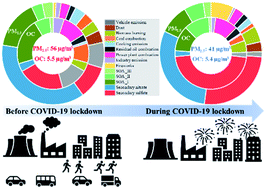
Faraday Discuss., 2021,226, 112-137
https://doi.org/10.1039/D0FD00091D
Is reducing new particle formation a plausible solution to mitigate particulate air pollution in Beijing and other Chinese megacities?
Based on our comprehensive observations in Beijing, we show that 80–90% of PM2.5 was formed via atmospheric reactions during haze days and over 65% of the number concentration of haze particles resulted from new particle formation.
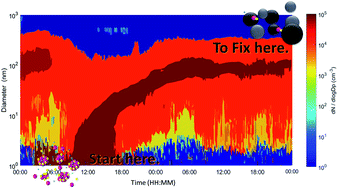
Faraday Discuss., 2021,226, 334-347
https://doi.org/10.1039/D0FD00078G
Using a coupled LES aerosol–radiation model to investigate the importance of aerosol–boundary layer feedback in a Beijing haze episode
In this study we use a coupled LES aerosol–radiation model (UCLALES-SALSA), which we have recently configured for the urban environment of Beijing.

Faraday Discuss., 2021,226, 173-190
https://doi.org/10.1039/D0FD00085J
Long-term trends in the contribution of PM2.5 sources to organic carbon (OC) in the Los Angeles basin and the effect of PM emission regulations
We investigated the long-term variations in the contributions of emission sources to ambient PM2.5 organic carbon (OC) in central Los Angeles (CELA) and Riverside using the Chemical Speciation Network (CSN) database in the 2005–2015 period.
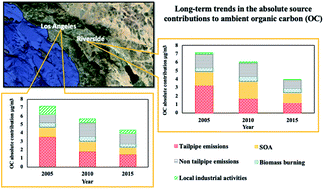
Faraday Discuss., 2021,226, 74-99
https://doi.org/10.1039/D0FD00074D
Molecular characterization of size-segregated organic aerosols in the urban boundary layer in wintertime Beijing by FT-ICR MS
Our study provides unique information on the vertical profiles and size distribution of urban organic aerosols by FT-ICR MS.
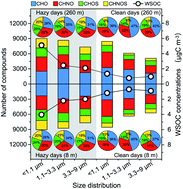
Faraday Discuss., 2021,226, 457-478
https://doi.org/10.1039/D0FD00084A
Sources of non-methane hydrocarbons in surface air in Delhi, India
Characterisation of the sources of non-methane volatile organic compounds in surface air in Delhi, India.
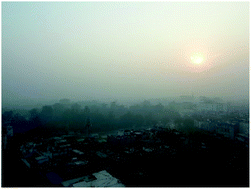
Faraday Discuss., 2021,226, 409-431
https://doi.org/10.1039/D0FD00087F
Variability of physical meteorology in urban areas at different scales: implications for air quality
AQ in cities varies in time and space with the atmosphere's physical state. UBL seasonal–diurnal variations (Beijing, Paris) will impact AQ. Isolated and clusters of tall buildings affect flow and pollutant exchange (London, Beijing).
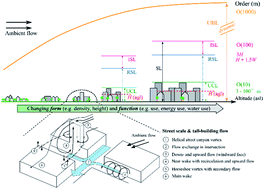
Faraday Discuss., 2021,226, 149-172
https://doi.org/10.1039/D0FD00098A
Air quality and health benefits of China’s current and upcoming clean air policies
We estimated China's clean air policies could ensure majority population lives below 35μg m−3, avoiding ∼95.0 thousand premature deaths in 2030.
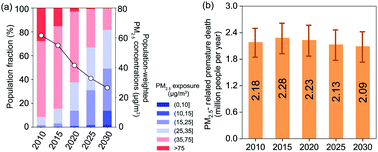
Faraday Discuss., 2021,226, 584-606
https://doi.org/10.1039/D0FD00090F
Avoiding high ozone pollution in Delhi, India
Quantify the influence of aerosol light extinction on surface ozone photochemistry, highlight controlling VOC for improving air quality in Delhi.
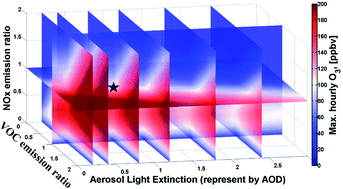
Faraday Discuss., 2021,226, 502-514
https://doi.org/10.1039/D0FD00079E
Formation and growth of sub-3 nm particles in megacities: impact of background aerosols
In polluted urban environments, background aerosols govern the formation and growth of sub-3 nm particles.
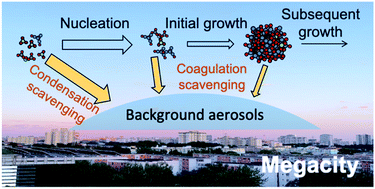
Faraday Discuss., 2021,226, 348-363
https://doi.org/10.1039/D0FD00083C
A component-specific exposure–mortality model for ambient PM2.5 in China: findings from nationwide epidemiology based on outputs from a chemical transport model
We conducted a whole-population-based epidemiology study using the Chinese Population Census of deaths and PM2.5 concentrations and components, during 2000–2010, to model how chemical composition affects the health impact of PM2.5 exposure.
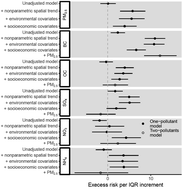
Faraday Discuss., 2021,226, 551-568
https://doi.org/10.1039/D0FD00093K
General discussion: Multiphase atmospheric chemistry, and source apportionment
Faraday Discuss., 2021,226, 314-333
https://doi.org/10.1039/D1FD90015C
General discussion: Trends in emissions concentrations
Faraday Discuss., 2021,226, 100-111
https://doi.org/10.1039/D1FD90013G
General discussion: Aerosol formation and growth; VOC sources and secondary organic aerosols
Faraday Discuss., 2021,226, 479-501
https://doi.org/10.1039/D1FD90011K
General discussion: Urban air quality; Meteorological influences and air quality trends
Faraday Discuss., 2021,226, 191-206
https://doi.org/10.1039/D1FD90014E
General discussion: Sources, sinks and mitigation methods; evaluation of health impacts
Faraday Discuss., 2021,226, 607-616
https://doi.org/10.1039/D1FD90012A
About this collection
We are delighted to share with you a selection of the papers associated with a Faraday Discussion on Air quality in megacities. More information about the event may be found here: http://rsc.li/airquality-fd2020. Additional articles will be added to the collection as they are published. The final versions of all the articles presented and a record of the live discussions will be published after the event.
Chemistry plays a role both for the transported and the local emissions, and whereas for the primary (emitted) pollutants, concentrations are likely to be reduced proportionately with reductions in emissions, in the case of secondary pollutants formed within the atmosphere, the relationship between precursor emissions and reaction products is often strongly non-linear. This discussion aims to improve our understanding of the underlying processes responsible; an essential pre-requisite to developing the high quality numerical models of urban air pollutants which are required to develop and test mitigation strategies prior to implementation.